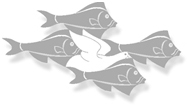

|
|
|
|
In traditional image reproduction techniques, halftones are generated by using small black screen elements of variable size. Since the image to be reproduced is what must be emphasized, these elements are rendered as unobtrusive as possible. Despite such precautions, their layout may sometimes mean that undesirable motives such as rosettes or moiré effects become visible. Rather than try to hide the artifice which gave rise to the image, as classical techniques do, it is possible to highlight it. In this case the screen elements are used as a means of expression in their own right.
1046 x 1328 Enlargment (1.1 MB)
Thanks to artistic screening, the graphic designer may tune the screen elements themselves. Their shape can be freely adapted to the content of the image they are to reproduce, thus conveying their own message through the screen, independently of the image whose illusion they recreate. Moreover, this shape is not fixed and may vary inside the image according to the level of intensity which is being reproduced.
This means that it is possible to design images offering several reading levels, whose meaning varies as one gets nearer to it. Finally, it is also possible to apply geometric transformations to the screen elements so as to produce effects which are often spectacular.
The two modules of the ScreenArt software implement the artistic screening process on the Macintosh. The screen dot elements are first drawn interactively using ScreenArt Designer, an extension of Adbe Illustrator. Based on these elements, the ScreenArt Renderer software then creates an artistic screen which can be used to reproduce a halftone image. Each module has been designed so that it may be used by an artist having a limited knowledge of traditional graphic tools on the Macintosh.
Because it allows the design of non-regular screens that cannot be accurately scanned or reproduced by photocopy, artistic screening is also well suited for security printing. It is thus possible to create images that will display strong alterations if they are copied by traditional means. Such images can be incorporated into bank notes or credit cards, improving their resistance against counterfeiting in an inexpensive manner.
Artistic screening is mainly aimed at graphic art professionals. The images created thanks to this technique can be used simply for their esthetic qualities and are particularly well-suited to the production of large-sized posters. Advertising posters created in this way will certainly attract a lot of attention because of their content which varies with distance. A real-life example of such a poster has been realized for the 200th birthday of the Swiss writer Jeremias Gotthelf. A 30m x 8m poster of a fragment of his portrait was screened with one of his literary creations. This poster was then mounted on a hill nearby Lützelfüh, Gotthelf's native village, and has stayed there during the year 1997.
1160 x 443 Enlargment (780 KB)